Northern Namibia
November 20th - December 4th, 1999
We left Drotksy's early in the morning, but not before engaging the owners
in a discussion about the storm
of the previous evening and the damage they sustained. They warned us
to be careful on the highway, as a couple who had left the day before had
their vacation dramatically shortened when they collided with a buffalo
grazing on the road. They were ok and were able to limp their mangled truck
home, but it came as a shock as we just had dinner with them two nights
before and they had that same vacation/explorer glow that we walk around
with. If it can happen to them, it can happen to us.
Interestingly, our feelings of mortality co-incided with our first foray
of the trip into a recently active war zone: Namibia's Caprivi strip. While
we were in Morocco we had heard of rebel uprisings over our shortwave radio
and how the Namibian government quickly squashed them and were now "interrogating"
the ringleaders in some dark hellhole of a prison. The region has been quiet
since then, and other tourons coming from there confirm that all is cool.
Caprivi is an interesting artifact of the colonial chess match waged
in the 19th century in Africa. The strip was tacked onto Namibia when they
called this area SouthWest Africa and it was under the colonial thumb of
the Germans. The Germans got it in a swap with the English; the Brits got
Zanzibar and the Germans got Caprivi and some insignificant seagull nest
of an island in the North Sea off the coast of Germany. Had logic prevailed,
this strip of land would have gone to Botswana, Angola or Zambia, but now
gives Namibia its only well watered and productive farmland.
We had gotten a glimpse of the Caprivi when at Chobe, and all we saw
were cabbage and cattle. Since this strip is Namibia's sole usable farmland,
it has been developed to the hilt and almost all the wildlife is gone. Not
prime touring material. Once we got through the laughably small border crossing
(a desk, a picnic table and a manually opened chain link road gate), we
shot through Caprivi and only stopped when we hit the town of Rundu near
the Angolan border, where we overnighted.
Rundu itself is one of those supply towns, providing modern services
and goods to Caprivi and the undeveloped northwest Namibian corner. We got
our first taste of what it means to be in Namibia on a Sunday when we found
the town deserted and we had to scrounge for supplies at the Shell's stations
meager larder. Desperately poor Africans hang out at the service station,
buzzing around you like flies. We share a package of crackers with some
children (we've decided the adults are a lost cause and only help children)
and head south.
Postscript: It turns out that when
we were in Rundu, Namibia had covertly given permission for the Angolan
government to conduct operations against rebels that were using Namibia
as their base. At a service station we saw a left-hand drive jeep-type vehicle
with four people in fatigues that gave us the once over and then continued
with their business -- they must have been part of the Angolan force. The
whole region has since destabilized and now both civilians and tourists
have been killed. Namibia is talking about calling up men into the army
and is preparing to wage war with UNITA and Jonas Savimbi, the best bush
fighter in the world. Tourists are giving Namibia a wide berth and it's
anyone's guess what will happen next.
Hoba Meteor
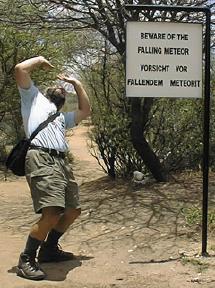 As we leave Rundu, our plans (as usual) are ill-formed. Not
a problem, as all reasonable roads leading from the Caprivi head for a trinity
of Namibian towns: Grootfontein, Tsumeb, and Otavi. We've heard good things
about each and our curious ourselves about which one we'll stay at first.
Our big problem is that our first day exploring Namibia is a Sunday. As
Namibia was once a German colony and to this day retains not only the German
language but most of the old German customs, Sunday is the day of rest.
Period. The only thing you'll find open in Namibia on a Sunday is some of
the petrol stations. This makes it tough to suss out a town, and was our
first introduction to what the locals mean when they say "Namibia is
more German than Germany."
As we leave Rundu, our plans (as usual) are ill-formed. Not
a problem, as all reasonable roads leading from the Caprivi head for a trinity
of Namibian towns: Grootfontein, Tsumeb, and Otavi. We've heard good things
about each and our curious ourselves about which one we'll stay at first.
Our big problem is that our first day exploring Namibia is a Sunday. As
Namibia was once a German colony and to this day retains not only the German
language but most of the old German customs, Sunday is the day of rest.
Period. The only thing you'll find open in Namibia on a Sunday is some of
the petrol stations. This makes it tough to suss out a town, and was our
first introduction to what the locals mean when they say "Namibia is
more German than Germany."
We visit the first town one reaches from the Caprivi, Grootfontein, and
find it closed. Shame, as we hear it's a town geared for tourists and is
a nice experience. Undaunted, we decide to head for our second choice of
the trinity, Tsumeb, and while bombing down the road we see the turnoff
for the Hoba Meteor. Having been occasionally accused of being of alien
origins, we can't pass up the real thing and head down the seventeen kilometers
of dirt road to see the largest known meteor to strike the Earth.
We have to admit, we thought we would see craters, ejecta and such before
we actually arrived at the site of the metor. After all, the world's largest
meteor should leave a pretty big dent, right? It was with great surprise
that we drove along a perfectly normal dirt road passing by perfectly normal
ranchland until we came upon the turn for the meteor. After paying our entrance
fee were told that "yes, it's just a short walk this way." Odd.
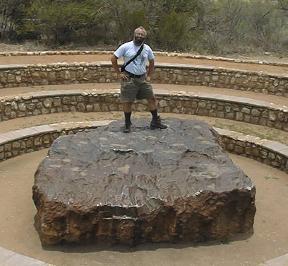 We walked along a short and groomed path and came upon a
small amphitheater centered upon this huge piece of iron. Weighing at sixty
tons, the Hoba meteor does indeed look like all those meteors you see in
the museums, just a lot larger. Technically an ataxite, it's believed that
Hoba was part of a much larger asteroid that hit the Earth 80,000 years
ago.
We walked along a short and groomed path and came upon a
small amphitheater centered upon this huge piece of iron. Weighing at sixty
tons, the Hoba meteor does indeed look like all those meteors you see in
the museums, just a lot larger. Technically an ataxite, it's believed that
Hoba was part of a much larger asteroid that hit the Earth 80,000 years
ago.
Found by a hunter in the 1920's, the meteor for a long time was only
known by "insiders", many of whom chopped off little pieces with
their hacksaws for their souvenir collection. Declared a national monument
in 1955, the odd cuboid shape of the meteor suggests that there are other
hunks of the original asteroid that await discovery.
We left Hoba amazed that 80,000 years was long enough to weather away
the impact crater that the meteor left upon this little corner of Africa.
Perhaps it's our preconception of the desert and other arid lands as static
places, but we left with an understanding of how dynamic Namibian ecology
and geology must be.
Tsumeb
 Continuing on to Tsumeb, we found a town only slightly more
open than the last one. We were able to stock up on some basic foodstuffs
and beer before grabbing a campsite in the town's caravan park and weathering
a rainy evening. The next day we treat ourselves to a room in town in celebration
of Kathy's birthday and spend the day touring the town's sights. Tsumeb
has seen fatter days, back when the town's mine was open. Seems that Tsumeb
is located on top of a gigantic plume of copper, lead and other metals.
Tsumeb once provided much of the world's supply of these metals, and is
the sole location of a number of mineral composites. The mines survived
the crash in copper and other metal prices, only to go bankrupt three years
ago when a prolonged strike forced unsustainable labor costs upon it. Many
other businesses, dependent upon the money mining brought into town, have
also closed rendering Tsumeb a sleepy place on the busiest of days.
Continuing on to Tsumeb, we found a town only slightly more
open than the last one. We were able to stock up on some basic foodstuffs
and beer before grabbing a campsite in the town's caravan park and weathering
a rainy evening. The next day we treat ourselves to a room in town in celebration
of Kathy's birthday and spend the day touring the town's sights. Tsumeb
has seen fatter days, back when the town's mine was open. Seems that Tsumeb
is located on top of a gigantic plume of copper, lead and other metals.
Tsumeb once provided much of the world's supply of these metals, and is
the sole location of a number of mineral composites. The mines survived
the crash in copper and other metal prices, only to go bankrupt three years
ago when a prolonged strike forced unsustainable labor costs upon it. Many
other businesses, dependent upon the money mining brought into town, have
also closed rendering Tsumeb a sleepy place on the busiest of days.
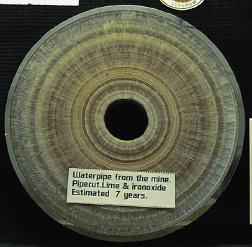 The glory days of Tsumeb are remembered in the its museum,
dedicated to the town's German fathers and the indigenous population they
displaced. Some of our favorite displays were the 19th century steam engine
(left) and the cross section of one of the mine's water pipes that was showing
reduced water flow (right); can you see why?
The glory days of Tsumeb are remembered in the its museum,
dedicated to the town's German fathers and the indigenous population they
displaced. Some of our favorite displays were the 19th century steam engine
(left) and the cross section of one of the mine's water pipes that was showing
reduced water flow (right); can you see why?
Perhaps the most interesting aspect of life in Tsumeb is that peoples'
preferred language is German, even though the German colonial period ended
86 years ago. It's not some odd dialect of German either; it's perfect hoch
Deutsch, or standard high German. Most everyone can speak English and
Afrikaans as well, and the common indigenous languages are by and large
various dialects of Bantu. German, though, is the language that binds them
all. Rather odd being panhandled in German in Africa.
Lake Otjikoto
On the way from Tsumeb to Etosha National Park lies Namibia's two and
only naturally occurring lakes. Actually giant sinkholes that have filled
with water, one lies along our route and was impossible to pass up. Lake
Otjikoto measures 55 meters deep and once provided Tsumeb with all of its
fresh water, pumped the nearly twenty kilometers to town by a grand old
brick and steel German steam pump (currently under restoration). Very impressive,
especially considering it was put together at the end of the 19th century
in the middle of nowhere.
Etosha National Park
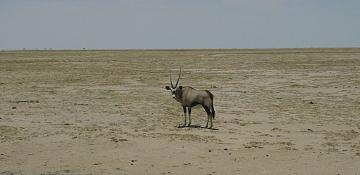
We must admit that when we entered Namibia, we thought we would be embarking
on a different phase of the trip. Ever since we left Harare we've been hopping
from game park to game park, camping and gawking at critters. Our guess
it would be a while before we went to another game park, but as we talked
with the locals and fellow travelers, they all said "You must go to
Etosha." Off we went, believing that more animal watching would be
a bit of a yawn, having done exactly that for over a month now. And how
many animals can there be in a brutal desert, after all?
In this place that the desert people of Namibia call hellish we found
a land teeming with more wildlife than you could expect. Our first sighting
was a large herd of giraffe, loping across the hard desert pack. You can't
fully understand the grace of the giraffe until you've seen them running.
Their necks almost seem to swim through the air and their long legs reveal
to you the ballet of the gallop that the fury of a horse's shorter legs
conceal.
New and very striking animals showed themselves on the arid planes. Our
favorite were the gemsboks (pictured above), with big chests, very distinctive
black and white facial patterns, and these unworldly long and pointed horns.
We hear they can go a month without water. Also new to us was the hartebeest
(no good pics, sorry) which gets its name from its reddish hue and its heart-shaped
horns.
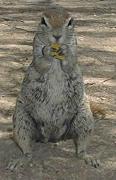 Even the campground critters were a trip. We made two buddies
at one campground: this squirrel who had a thing for deep fried peri-peri
corn chips, and a hornbill with a dislocated leg. Twisted halfway around
with what looked like a recent injury, we couldn't imagine that it didn't
hurt. It didn't deter the bird from anything, as we witnessed it swoop in,
grab a ten centimeter baboon spider we were watching near Spot's tire, kill
it, and then proceed to choke it down. Got it with the first grab, too.
Even the campground critters were a trip. We made two buddies
at one campground: this squirrel who had a thing for deep fried peri-peri
corn chips, and a hornbill with a dislocated leg. Twisted halfway around
with what looked like a recent injury, we couldn't imagine that it didn't
hurt. It didn't deter the bird from anything, as we witnessed it swoop in,
grab a ten centimeter baboon spider we were watching near Spot's tire, kill
it, and then proceed to choke it down. Got it with the first grab, too.
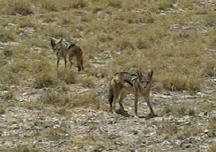 Most of the other animals in the African dance also live
in Etosha. Etosha's strain of animals tend to have unique qualities. The
lion here in Etosha is prized by zoos and breeders all around the world
as it is completely free of feline aids, isolated as it is from the rest
of this continent in which aids runs rampant, among the cats as well as
humans. The Namibian elephant has longer legs and needs much less water
than other African elephants.
Most of the other animals in the African dance also live
in Etosha. Etosha's strain of animals tend to have unique qualities. The
lion here in Etosha is prized by zoos and breeders all around the world
as it is completely free of feline aids, isolated as it is from the rest
of this continent in which aids runs rampant, among the cats as well as
humans. The Namibian elephant has longer legs and needs much less water
than other African elephants.
We caught on camera what had eluded us so far this trip: a good shot
of a jackal. Two actually, flushed out when we cruised Spot over the drain
pipe in which they were hiding. One of the animals most wary of humans,
we've only been able to get quick glimpses of them. Not these two; they
waited until we drove away to get back in their hidey-hole.
Moringa Waterhole
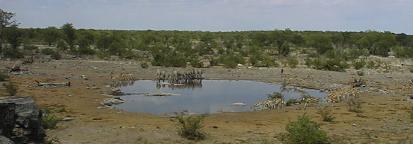
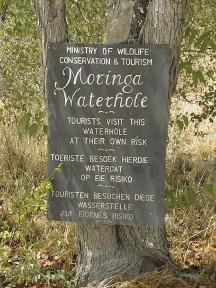 While visiting Etosha and viewing it in the manner that we've
seen other game parks would have been most pleasant and rewarding, the touch
that lifts Etosha from being a good game park to being one of the world's
best is its three waterholes, Okaukuejo, King Nehale, and Moringa. On the
edge of its three main campgrounds, these permanent waterholes serve as
magnets for animals and tourists alike and allows an unfettered, up-front
and unrivaled view of African wildlife.
While visiting Etosha and viewing it in the manner that we've
seen other game parks would have been most pleasant and rewarding, the touch
that lifts Etosha from being a good game park to being one of the world's
best is its three waterholes, Okaukuejo, King Nehale, and Moringa. On the
edge of its three main campgrounds, these permanent waterholes serve as
magnets for animals and tourists alike and allows an unfettered, up-front
and unrivaled view of African wildlife.
What makes the Etosha waterhole experiences unique is that you can watch
the wildlife safely at night. Every wildlife park we've visited in Africa
so far close the gates of their campgrounds at sunset and don't unlock them
until sunrise, so it's impossible to view wildlife at night. Etosha's waterholes
are adjacent to the main campgrounds and never close, so you can wander
over any time of day or night and check out the scene. Nocturnal species
that normally are so difficult to spot trot right out on main stage, eye
the crowd warily, and then take a nice, long drink.
Our favorite was Moringa Waterhole in the Halalie campgrounds. With the
rainy season just beginning, groundwater levels are so low that Etosha's
animals have very few choices on where to get a drink. Moringa is the only
water around for at least fifty kilometers, so during the dry winter all
the animals in the area must, sooner or later, come here.
A few rains have already kissed Namibia, so the most shy of African wildlife
can minimize the number of visits they must make to the waterholes. Our
leopard still eludes us, but just about everything else made a visit to
Moringa, including several rhino families. As the rains have taken the edge
off of most of the animals' thirst, the natural pecking order now applies
at the waterholes. One rhino family, obviously anxious for water, waited
at a distance for over half an hour while a group of elephants lingered
over a drink. Even sending the smallest and least threatening rhino cub
forward elicited an unmistakable "get back" message from the elephants.
We didn't realize it until actually seeing the waterhole, but we've seen
video of Moringa on PBS nature shows. Taken during one winter during the
drought years of the early nineties, normal animal behavior had completely
broken down and lions, leopards and their normal prey animals drank side
by side, driven together by their common thirst. There seems to be a seldom
broken law that predators won't attack prey near these waterholes.
 On our second visit to Etosha we witnessed
this elephant fight to the right. The battle was over who got to drink from
the "sweet spot" where the water comes right from the spigot.
We were of the impression that for these two elephants this has been brewing
for a while and waterhole was just the spark.
On our second visit to Etosha we witnessed
this elephant fight to the right. The battle was over who got to drink from
the "sweet spot" where the water comes right from the spigot.
We were of the impression that for these two elephants this has been brewing
for a while and waterhole was just the spark.
Finally, we found the Okaukuejo waterhole to also offer quality wildlife
viewing. The place to spy rhinos, the waterhole is ringed by huts and rondavels
making for a crowded evening's viewing. Just before midnight, though, everyone
turns in and it's just you and the rhinos. The last waterhole, King Nehale
in Namutoni campgrounds, is mostly filled with reeds and while it makes
for nice bird and frog watching, it attracts few large animals.
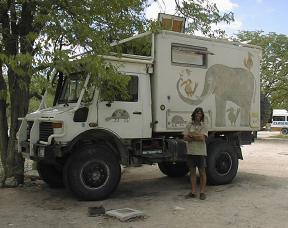 Our second visit was twice fortunate
for us, as we were able to meet Fritz the German, a wildlife biologist who's
been coming to Namibia for over ten years now, staying months at a time.
He tours the wilds here with the Cadillac of the 4WD club here: a Unimog
(oo-nee-mach). Built by Mercedes for use as a tractor, the Unimog has an
incredible ground clearance using offset axles similar to the Hummvee. Fritz
here has outfitted his as a mobile research lab and crashpad. Teutonic in
perfection, his Unimog allows him to be completely self-sufficient for several
weeks at a time.
Our second visit was twice fortunate
for us, as we were able to meet Fritz the German, a wildlife biologist who's
been coming to Namibia for over ten years now, staying months at a time.
He tours the wilds here with the Cadillac of the 4WD club here: a Unimog
(oo-nee-mach). Built by Mercedes for use as a tractor, the Unimog has an
incredible ground clearance using offset axles similar to the Hummvee. Fritz
here has outfitted his as a mobile research lab and crashpad. Teutonic in
perfection, his Unimog allows him to be completely self-sufficient for several
weeks at a time.
We've seen a few of these Unimogs here, and more than one of them have
been outfitted as mobile bachelor pads. It makes perfect sense; your apartment
on wheels that can go anywhere in Africa.
Outjo
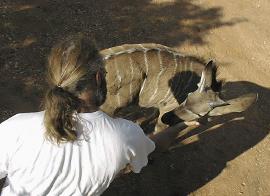 Outjo will always be memorable in our minds as it's the city
where our first major truck trauma
happened. Our rear axle crapped out, which meant that we could only move
the truck by engaging 4WD and dragging it around on the front axle. We take
it to a mechanic and find the flange fitted to one sides' axle shaft has
worn all of its gear splines clean off. The other side is bad too, so we
order parts but they're going to take a week to arrive. We get the flange
and axle shaft welded together and take it easy, with no four-wheeling or
high speeds until we get it fixed. At least our campground had a stress-reducing
pet kudu you could play with. Most of the good rubs that work with cats
work with kudus, although they do make problematic lap pets.
Outjo will always be memorable in our minds as it's the city
where our first major truck trauma
happened. Our rear axle crapped out, which meant that we could only move
the truck by engaging 4WD and dragging it around on the front axle. We take
it to a mechanic and find the flange fitted to one sides' axle shaft has
worn all of its gear splines clean off. The other side is bad too, so we
order parts but they're going to take a week to arrive. We get the flange
and axle shaft welded together and take it easy, with no four-wheeling or
high speeds until we get it fixed. At least our campground had a stress-reducing
pet kudu you could play with. Most of the good rubs that work with cats
work with kudus, although they do make problematic lap pets.
At least the axle incident allowed us a second chance to visit Etosha
and see the change a big rainstorm brings. Animal sightings at the waterholes
decreased dramatically, and the foliage was noticeably denser than before
making spotting the critters in the bush very difficult. Made it all too
obvious why many people visit southern Africa in the dry winter season.
Waterberg Plateau

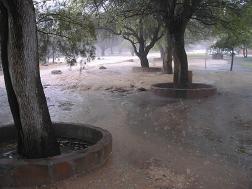 After Etosha, we stay one last rainy night in Outjo and the
next morning take Spot to the mechanics to have our new axle shafts and
flanges fitted. Fully mobile once again, we shoot straight south on the
road to the capitol of Namibia, Windhoek. We break up the trip with a visit
to Waterberg Plateau with the idea of checking it out for a night and staying
if we like it. We arrived just before the rain gods opened the zipper and
made an already muddy park soaking wet (our campground to the right).
After Etosha, we stay one last rainy night in Outjo and the
next morning take Spot to the mechanics to have our new axle shafts and
flanges fitted. Fully mobile once again, we shoot straight south on the
road to the capitol of Namibia, Windhoek. We break up the trip with a visit
to Waterberg Plateau with the idea of checking it out for a night and staying
if we like it. We arrived just before the rain gods opened the zipper and
made an already muddy park soaking wet (our campground to the right).
We have to admit that had it been raining when we arrived we might have
skipped the park altogether. However, since the fifty kilometer long unbroken
line of the plateau has us hooked (and we've paid our gate fee) we're staying.
Days like this we just grab a book, hop in the tent and wait for the rain
to end. Between yesterday's and today's rains, Waterberg has seen almost
a third of its annual rainfall. It did stop during the afternoon, and left
us with beautifully mottled clouds for sunset.
That evening the rain gave birth to millions of winged bugs. In their
annual mating dance, they filled the skies and the ground. Lizards abounded
everywhere, gulping them down like potato chips. The piles of bugs everywhere
were simply incredible.
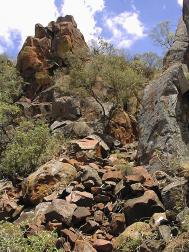
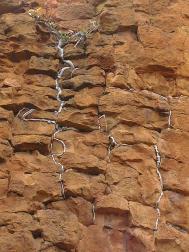 We were awed at the speed at which
this arid land drank up the water. By the next morning almost all the standing
water was gone, and the hot sun baked once again. We decided to hike to
the top of the plateau and to the beginning of the 42 kilometer long distance
permit trail. The path to the top (photo left) was a bit challenging but
nothing technical, and the view offered of the surrounding pancake terrain
was well worth the exertion.
We were awed at the speed at which
this arid land drank up the water. By the next morning almost all the standing
water was gone, and the hot sun baked once again. We decided to hike to
the top of the plateau and to the beginning of the 42 kilometer long distance
permit trail. The path to the top (photo left) was a bit challenging but
nothing technical, and the view offered of the surrounding pancake terrain
was well worth the exertion.
Despite not having trail permits, we decide to venture into the back
country unescorted for a few kilometers. The reddish sandstone rock found
at Waterberg weathers in odd ways, with columns and arches to be found all
around. Plants and animals integrate themselves within all the rock niches,
as shown by this fig tree to the right. This trail is only open between
April and November, and would make a delightful four day hike.
 Adjacent to the campgrounds were an old German military graveyard
and a delightful aloe tree forest. Awakened by this week's rains, the forest
was populated with all sorts of insects. We found our first dung beetles
here at Waterberg, and found the manner they go about their work fascinating.
Bright red bugs crawled all across the paths like little Martians.
Adjacent to the campgrounds were an old German military graveyard
and a delightful aloe tree forest. Awakened by this week's rains, the forest
was populated with all sorts of insects. We found our first dung beetles
here at Waterberg, and found the manner they go about their work fascinating.
Bright red bugs crawled all across the paths like little Martians.
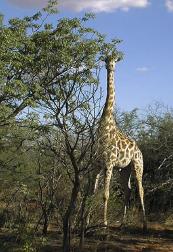 Finally, on our last full day in Waterberg we took a drive
with one of the park's rangers to the opposite side of the plateau. With
no camping allowed, the game have this section of the park all to themselves.
We saw much more of the odd rock formations we found during our hikes near
camp, and viewed much of the park's larger animals. Although they were introduced
into the parks in the days Waterberg was administered by South Africa, giraffes
now make Waterberg their home and blend in well with the plateau's veld.
Finally, on our last full day in Waterberg we took a drive
with one of the park's rangers to the opposite side of the plateau. With
no camping allowed, the game have this section of the park all to themselves.
We saw much more of the odd rock formations we found during our hikes near
camp, and viewed much of the park's larger animals. Although they were introduced
into the parks in the days Waterberg was administered by South Africa, giraffes
now make Waterberg their home and blend in well with the plateau's veld.
 As we leave Rundu, our plans (as usual) are ill-formed. Not
a problem, as all reasonable roads leading from the Caprivi head for a trinity
of Namibian towns: Grootfontein, Tsumeb, and Otavi. We've heard good things
about each and our curious ourselves about which one we'll stay at first.
Our big problem is that our first day exploring Namibia is a Sunday. As
Namibia was once a German colony and to this day retains not only the German
language but most of the old German customs, Sunday is the day of rest.
Period. The only thing you'll find open in Namibia on a Sunday is some of
the petrol stations. This makes it tough to suss out a town, and was our
first introduction to what the locals mean when they say "Namibia is
more German than Germany."
As we leave Rundu, our plans (as usual) are ill-formed. Not
a problem, as all reasonable roads leading from the Caprivi head for a trinity
of Namibian towns: Grootfontein, Tsumeb, and Otavi. We've heard good things
about each and our curious ourselves about which one we'll stay at first.
Our big problem is that our first day exploring Namibia is a Sunday. As
Namibia was once a German colony and to this day retains not only the German
language but most of the old German customs, Sunday is the day of rest.
Period. The only thing you'll find open in Namibia on a Sunday is some of
the petrol stations. This makes it tough to suss out a town, and was our
first introduction to what the locals mean when they say "Namibia is
more German than Germany." We walked along a short and groomed path and came upon a
small amphitheater centered upon this huge piece of iron. Weighing at sixty
tons, the Hoba meteor does indeed look like all those meteors you see in
the museums, just a lot larger. Technically an ataxite, it's believed that
Hoba was part of a much larger asteroid that hit the Earth 80,000 years
ago.
We walked along a short and groomed path and came upon a
small amphitheater centered upon this huge piece of iron. Weighing at sixty
tons, the Hoba meteor does indeed look like all those meteors you see in
the museums, just a lot larger. Technically an ataxite, it's believed that
Hoba was part of a much larger asteroid that hit the Earth 80,000 years
ago. Continuing on to Tsumeb, we found a town only slightly more
open than the last one. We were able to stock up on some basic foodstuffs
and beer before grabbing a campsite in the town's caravan park and weathering
a rainy evening. The next day we treat ourselves to a room in town in celebration
of Kathy's birthday and spend the day touring the town's sights. Tsumeb
has seen fatter days, back when the town's mine was open. Seems that Tsumeb
is located on top of a gigantic plume of copper, lead and other metals.
Tsumeb once provided much of the world's supply of these metals, and is
the sole location of a number of mineral composites. The mines survived
the crash in copper and other metal prices, only to go bankrupt three years
ago when a prolonged strike forced unsustainable labor costs upon it. Many
other businesses, dependent upon the money mining brought into town, have
also closed rendering Tsumeb a sleepy place on the busiest of days.
Continuing on to Tsumeb, we found a town only slightly more
open than the last one. We were able to stock up on some basic foodstuffs
and beer before grabbing a campsite in the town's caravan park and weathering
a rainy evening. The next day we treat ourselves to a room in town in celebration
of Kathy's birthday and spend the day touring the town's sights. Tsumeb
has seen fatter days, back when the town's mine was open. Seems that Tsumeb
is located on top of a gigantic plume of copper, lead and other metals.
Tsumeb once provided much of the world's supply of these metals, and is
the sole location of a number of mineral composites. The mines survived
the crash in copper and other metal prices, only to go bankrupt three years
ago when a prolonged strike forced unsustainable labor costs upon it. Many
other businesses, dependent upon the money mining brought into town, have
also closed rendering Tsumeb a sleepy place on the busiest of days. The glory days of Tsumeb are remembered in the its museum,
dedicated to the town's German fathers and the indigenous population they
displaced. Some of our favorite displays were the 19th century steam engine
(left) and the cross section of one of the mine's water pipes that was showing
reduced water flow (right); can you see why?
The glory days of Tsumeb are remembered in the its museum,
dedicated to the town's German fathers and the indigenous population they
displaced. Some of our favorite displays were the 19th century steam engine
(left) and the cross section of one of the mine's water pipes that was showing
reduced water flow (right); can you see why?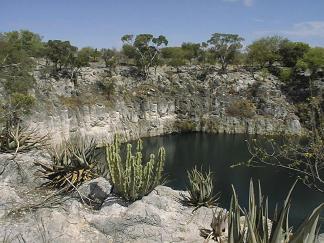
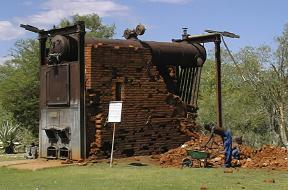

 Even the campground critters were a trip. We made two buddies
at one campground: this squirrel who had a thing for deep fried peri-peri
corn chips, and a hornbill with a dislocated leg. Twisted halfway around
with what looked like a recent injury, we couldn't imagine that it didn't
hurt. It didn't deter the bird from anything, as we witnessed it swoop in,
grab a ten centimeter baboon spider we were watching near Spot's tire, kill
it, and then proceed to choke it down. Got it with the first grab, too.
Even the campground critters were a trip. We made two buddies
at one campground: this squirrel who had a thing for deep fried peri-peri
corn chips, and a hornbill with a dislocated leg. Twisted halfway around
with what looked like a recent injury, we couldn't imagine that it didn't
hurt. It didn't deter the bird from anything, as we witnessed it swoop in,
grab a ten centimeter baboon spider we were watching near Spot's tire, kill
it, and then proceed to choke it down. Got it with the first grab, too. Most of the other animals in the African dance also live
in Etosha. Etosha's strain of animals tend to have unique qualities. The
lion here in Etosha is prized by zoos and breeders all around the world
as it is completely free of feline aids, isolated as it is from the rest
of this continent in which aids runs rampant, among the cats as well as
humans. The Namibian elephant has longer legs and needs much less water
than other African elephants.
Most of the other animals in the African dance also live
in Etosha. Etosha's strain of animals tend to have unique qualities. The
lion here in Etosha is prized by zoos and breeders all around the world
as it is completely free of feline aids, isolated as it is from the rest
of this continent in which aids runs rampant, among the cats as well as
humans. The Namibian elephant has longer legs and needs much less water
than other African elephants.
 While visiting Etosha and viewing it in the manner that we've
seen other game parks would have been most pleasant and rewarding, the touch
that lifts Etosha from being a good game park to being one of the world's
best is its three waterholes, Okaukuejo, King Nehale, and Moringa. On the
edge of its three main campgrounds, these permanent waterholes serve as
magnets for animals and tourists alike and allows an unfettered, up-front
and unrivaled view of African wildlife.
While visiting Etosha and viewing it in the manner that we've
seen other game parks would have been most pleasant and rewarding, the touch
that lifts Etosha from being a good game park to being one of the world's
best is its three waterholes, Okaukuejo, King Nehale, and Moringa. On the
edge of its three main campgrounds, these permanent waterholes serve as
magnets for animals and tourists alike and allows an unfettered, up-front
and unrivaled view of African wildlife. On our second visit to Etosha we witnessed
this elephant fight to the right. The battle was over who got to drink from
the "sweet spot" where the water comes right from the spigot.
We were of the impression that for these two elephants this has been brewing
for a while and waterhole was just the spark.
On our second visit to Etosha we witnessed
this elephant fight to the right. The battle was over who got to drink from
the "sweet spot" where the water comes right from the spigot.
We were of the impression that for these two elephants this has been brewing
for a while and waterhole was just the spark.
 Outjo will always be memorable in our minds as it's the city
where our
Outjo will always be memorable in our minds as it's the city
where our 
 After Etosha, we stay one last rainy night in Outjo and the
next morning take Spot to the mechanics to have our new axle shafts and
flanges fitted. Fully mobile once again, we shoot straight south on the
road to the capitol of Namibia, Windhoek. We break up the trip with a visit
to Waterberg Plateau with the idea of checking it out for a night and staying
if we like it. We arrived just before the rain gods opened the zipper and
made an already muddy park soaking wet (our campground to the right).
After Etosha, we stay one last rainy night in Outjo and the
next morning take Spot to the mechanics to have our new axle shafts and
flanges fitted. Fully mobile once again, we shoot straight south on the
road to the capitol of Namibia, Windhoek. We break up the trip with a visit
to Waterberg Plateau with the idea of checking it out for a night and staying
if we like it. We arrived just before the rain gods opened the zipper and
made an already muddy park soaking wet (our campground to the right).
 We were awed at the speed at which
this arid land drank up the water. By the next morning almost all the standing
water was gone, and the hot sun baked once again. We decided to hike to
the top of the plateau and to the beginning of the 42 kilometer long distance
permit trail. The path to the top (photo left) was a bit challenging but
nothing technical, and the view offered of the surrounding pancake terrain
was well worth the exertion.
We were awed at the speed at which
this arid land drank up the water. By the next morning almost all the standing
water was gone, and the hot sun baked once again. We decided to hike to
the top of the plateau and to the beginning of the 42 kilometer long distance
permit trail. The path to the top (photo left) was a bit challenging but
nothing technical, and the view offered of the surrounding pancake terrain
was well worth the exertion. Adjacent to the campgrounds were an old German military graveyard
and a delightful aloe tree forest. Awakened by this week's rains, the forest
was populated with all sorts of insects. We found our first dung beetles
here at Waterberg, and found the manner they go about their work fascinating.
Bright red bugs crawled all across the paths like little Martians.
Adjacent to the campgrounds were an old German military graveyard
and a delightful aloe tree forest. Awakened by this week's rains, the forest
was populated with all sorts of insects. We found our first dung beetles
here at Waterberg, and found the manner they go about their work fascinating.
Bright red bugs crawled all across the paths like little Martians. Finally, on our last full day in Waterberg we took a drive
with one of the park's rangers to the opposite side of the plateau. With
no camping allowed, the game have this section of the park all to themselves.
We saw much more of the odd rock formations we found during our hikes near
camp, and viewed much of the park's larger animals. Although they were introduced
into the parks in the days Waterberg was administered by South Africa, giraffes
now make Waterberg their home and blend in well with the plateau's veld.
Finally, on our last full day in Waterberg we took a drive
with one of the park's rangers to the opposite side of the plateau. With
no camping allowed, the game have this section of the park all to themselves.
We saw much more of the odd rock formations we found during our hikes near
camp, and viewed much of the park's larger animals. Although they were introduced
into the parks in the days Waterberg was administered by South Africa, giraffes
now make Waterberg their home and blend in well with the plateau's veld.